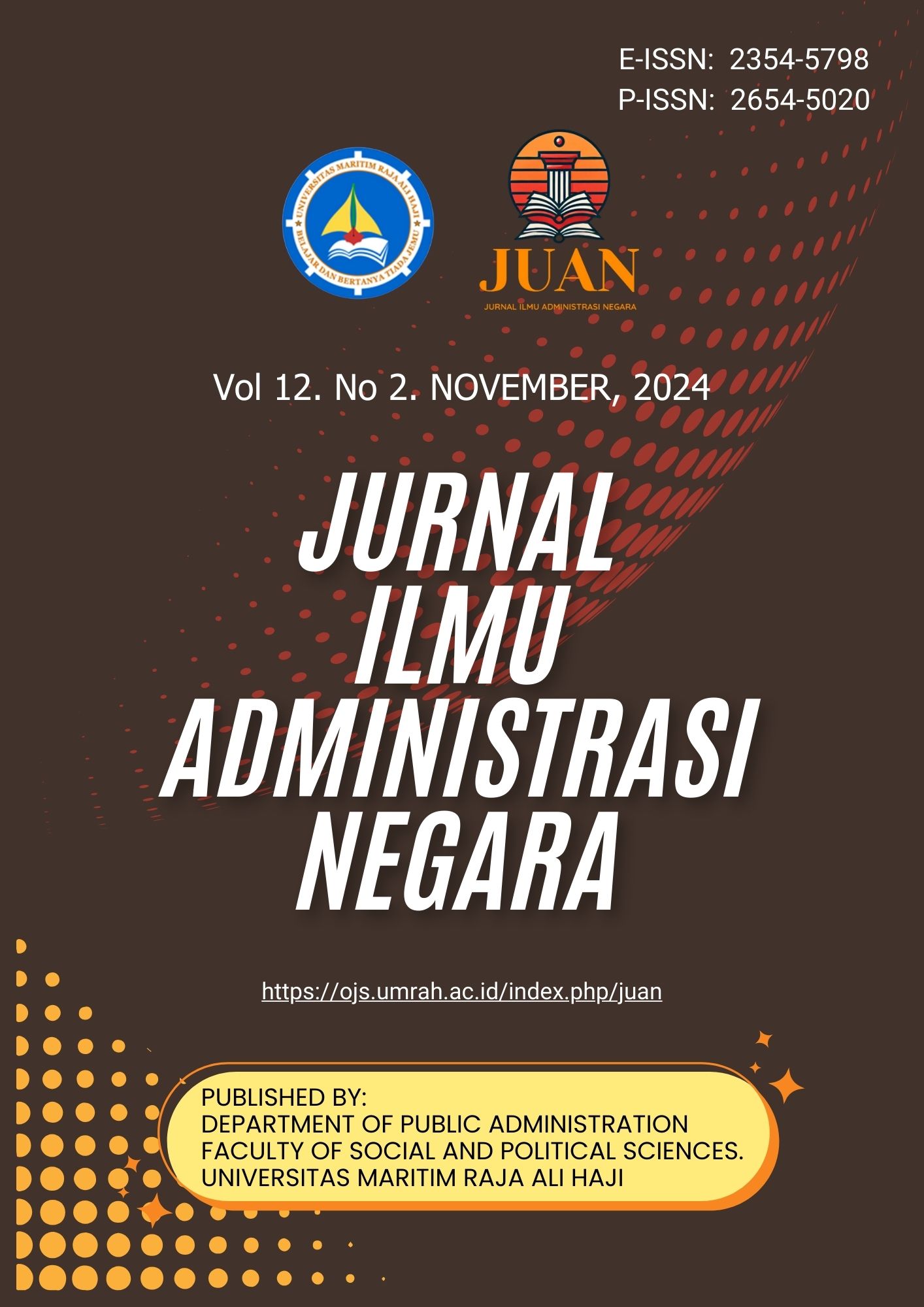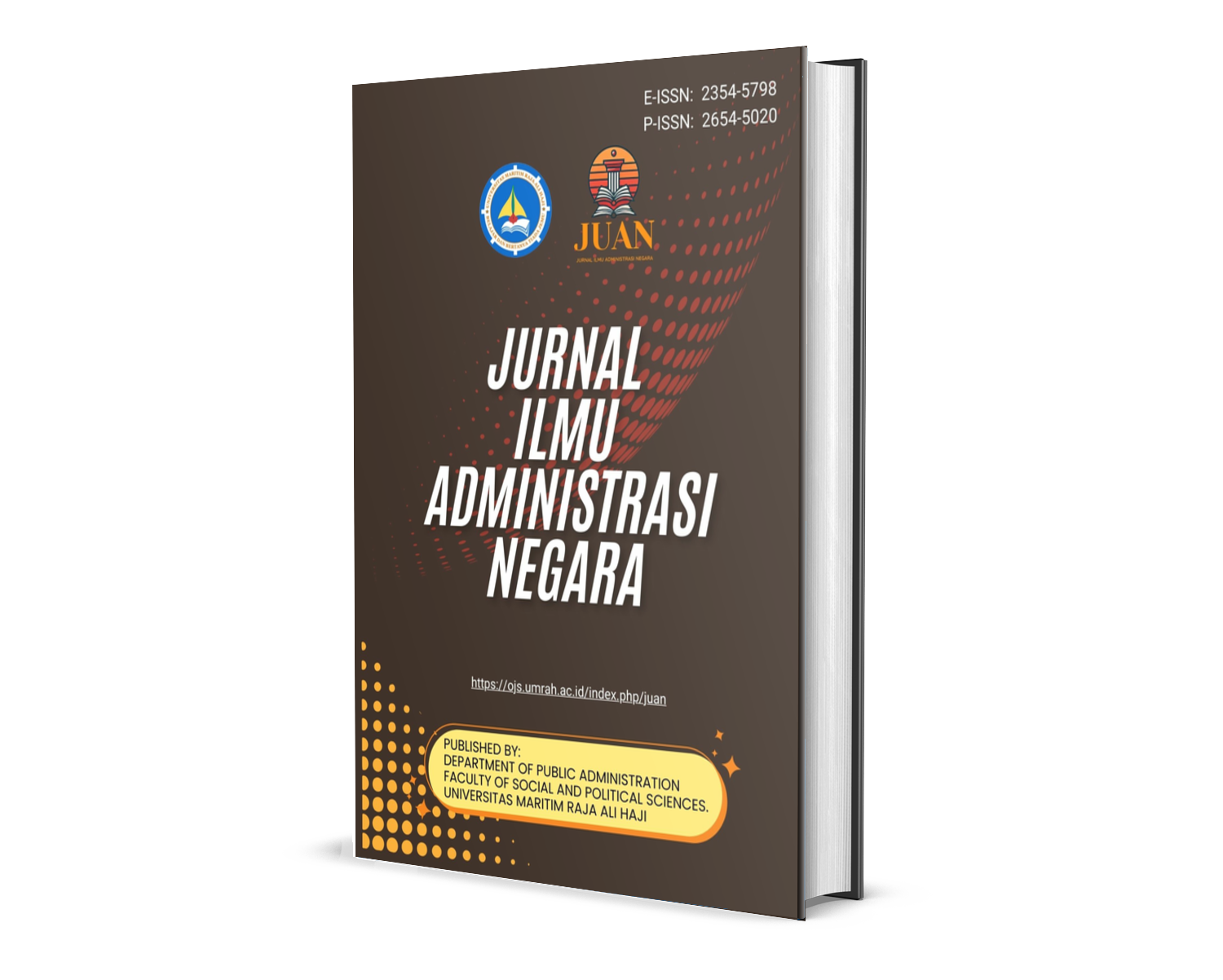Behavioral Intention of the Use of COVID-19 Governance Application: A Literature Review
DOI:
https://doi.org/10.31629/juan.v12i2.6955Keywords:
COVID-19 Governance, Application, TAM, Literature ReviewAbstract
The COVID-19 pandemic has had a profound impact on Indonesia, affecting not only public health but also socio-economic aspects of life. As part of its response to mitigate the spread of the virus, the Indonesian government introduced the PeduliLindungi application, which enables contact tracing and monitoring of COVID-19 cases through public participation. Despite its effectiveness in supporting policy decisions and reducing transmission rates, the application has faced criticism, particularly regarding potential privacy and human rights concerns. This study aims to analyze the behavioral intention of users to adopt the PeduliLindungi application using the Technology Acceptance Model (TAM) as a framework. The research employs a literature review approach, synthesizing findings from existing studies to identify key factors influencing user attitudes and intentions. Results indicate that perceived usefulness, perceived ease of use, and perceived risk are critical determinants of user attitudes. Furthermore, the study hypothesizes that user attitudes significantly influence behavioral intention, with trust in the application playing a reciprocal role. The findings highlight the importance of addressing user concerns, particularly regarding data security and privacy, to enhance adoption rates. This research contributes to the understanding of user behavior in adopting COVID-19 governance applications and provides a theoretical basis for future empirical studies. It concludes with recommendations for policymakers to ensure both the efficacy and ethical implementation of such technologies in public health crises.
References
Abdulkareem, A. K., & Ramli, R. M. (2022). Does trust in e-government influence the performance of e-government? An integration of information system success model and public value theory. Transforming Government: People, Process and Policy, 16(1), 1–17.
Ajzen, I. (1991). The theory of planned behavior. Organizational Behavior and Human Decision Processes, 50, 179–211.
Alalwan, A. A., Dwivedi, Y. K., & Rana, N. P. (2017). Factors influencing adoption of mobile banking by Jordanian bank customers: Extending UTAUT2 with trust. International Journal of Information Management, 37(3), 99–110.
Al-Hujran, O., Al-Debei, M. M., Chatfield, A., & Migdadi, M. (2015). The imperative of influencing citizen attitude toward e-government adoption and use. Computers in Human Behavior, 53, 189–203.
Alkraiji, A. I. (2021). An examination of citizen satisfaction with mandatory e-government services: comparison of two information systems success models. Transforming Government: People, Process and Policy, 15(1), 36–58. https://doi.org/10.1108/TG-01-2020-0015
Brown, S. A., Venkatesh, V., Kuruzovich, J., & Massey, A. P. (2008). Expectation confirmation: An examination of three competing models. Organizational Behavior and Human Decision Processes, 105(1), 52–66.
Chen, L., & Aklikokou, A. K. (2020). Determinants of e-government adoption: Testing the mediating effects of perceived usefulness and perceived ease of use. International Journal of Public Administration, 43(10), 850–865.
Davis, F. D. (1989). Perceived usefulness, perceived ease of use, and user acceptance of information technology. MIS Quarterly, 13(3), 319–339.
Davis, F. D. (1993). User acceptance of information technology: System characteristics, user perceptions and behavioral impacts. International Journal of Man-Machine Studies, 38(3), 475–487.
Dwivedi, Y. K., Rana, N. P., Janssen, M., Lal, B., Williams, M. D., & Clement, M. (2017). An empirical validation of a unified model of electronic government adoption (UMEGA). Government Information Quarterly, 34(2), 211–230.
Gefen, D., & Straub, D. (2000). The relative importance of perceived ease of use in IS adoption: A study of e-commerce adoption. Journal of the Association for Information Systems, 1(1), 1–30.
Gumussoy, C. A., Kaya, A., & Ozlu, E. (2018). Determinants of mobile banking use: An extended TAM with perceived risk, mobility access, compatibility, perceived self-efficacy and subjective norms. In F. Calisir & H. C. Akdag (Eds.), Industrial engineering in the industry 4.0 era (pp. 225–238). Springer International Publishing.
Hanafizadeh, P., Behboudi, M., Abedini Koshksaray, A., & Jalilvand Shirkhani Tabar, M. (2014). Mobile-banking adoption by Iranian bank clients. Telematics and Informatics, 31(1), 62–78.
Hubona, G. S., & Blanton, J. E. (1996). Evaluating system design features. International Journal of Human Computer Studies, 44(1), 93–118.
Kwon, S. J., Park, E., & Kim, K. J. (2014). What drives successful social networking services? A comparative analysis of user acceptance of Facebook and Twitter. Social Science Journal, 51(4), 534–544.
Pan, C. C., Sivo, S., Gunter, G., & Cornell, R. (2005). Students’ perceived ease of use of an eLearning management system: An exogenous or endogenous variable? Journal of Educational Computing Research, 33(3), 285–307.
Park, E., & Del Pobil, A. P. (2013). Modeling the user acceptance of long-term evolution (LTE) services. Annals of Telecommunications, 68(5–6), 307–315.
Pavlou, P. A. (2003). Consumer acceptance of electronic commerce: Integrating trust and risk with the technology acceptance model. International Journal of Electronic Commerce, 7(3), 101–134.
Rana, N. P., Dwivedi, Y. K., Williams, M. D., & Weerakkody, V. (2015). Investigating success of an e-government initiative: Validation of an integrated IS success model. Information Systems Frontiers, 17(1), 127–142.
Setiawan, R., & Mahadiansar, M. (2020). Forecasting analysis: The Riau Islands local government role In Covid-19 disaster management. Jurnal Studi Pemerintahan, 301-326.
Slade, E., Williams, M., Dwivedi, Y., & Piercy, N. (2015). Exploring consumer adoption of proximity mobile payments. Journal of Strategic Marketing, 23(3), 209–223.
U.S. Department of State. (2021). Indonesia 2021 human rights report. In 2021 Country reports on human rights practices (Issue April, pp. 1–60). Bureau of Democracy, Human Rights, and Labor.
Verkijika, S. F., & De Wet, L. (2018). E-government adoption in sub-Saharan Africa. Electronic Commerce Research and Applications, 30, 83–93.
Yoserizal, Y., Tovalini, K., Hanoselina, Y., & Yudiatmaja, W. E. (2023, July). A structural equation modeling of electronic learning application during COVID-19 outbreak. In AIP Conference Proceedings (Vol. 2798, No. 1). AIP Publishing.
Yudiatmaja, W. E., Prastya, I. Y., Meilinda, S. D., & Samnuzulsari, T. (2021). A systematic literature review of the research on traditional medicine policy. Mimbar: Jurnal Sosial Dan Pembangunan, 37(1).
Yudiatmaja, W. E., Salomo, R. V., & Prasojo, E. (2023). Leadership Styles and Employee’s Innovative Behavior: A Systematic Review Using Bibliometrics. The Journal of Behavioral Science, 18(3), 120-137.
Zahid, H., & Din, B. H. (2019). Determinants of intention to adopt e-government services in Pakistan: An imperative for sustainable development. Resources, 8(3).
Zahid, H., Ali, S., Abu-Shanab, E., & Javed, H. M. U. (2022). Determinants of intention to use e-government services: An integrated marketing relation view. Telematics and Informatics, 68, 101778.
Downloads
Published
How to Cite
Issue
Section
License
Copyright (c) 2024 Yoserizal Yoserizal, Krismena Tovalini, Yulia Hanoselina

This work is licensed under a Creative Commons Attribution-NonCommercial 4.0 International License.
You are free to:
- Share — copy and redistribute the material in any medium or format for any purpose, even commercially.
- Adapt — remix, transform, and build upon the material for any purpose, even commercially.
- The licensor cannot revoke these freedoms as long as you follow the license terms.
Under the following terms:
- Attribution — You must give appropriate credit, provide a link to the license, and indicate if changes were made . You may do so in any reasonable manner, but not in any way that suggests the licensor endorses you or your use.
- ShareAlike — If you remix, transform, or build upon the material, you must distribute your contributions under the same license as the original.
- No additional restrictions — You may not apply legal terms or technological measures that legally restrict others from doing anything the license permits.














